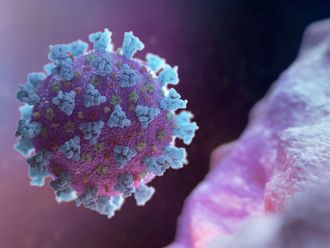
For all its peculiar horror, cancer comes with a saving grace. If nothing else can stop a tumour’s mad evolution, the cancer ultimately dies with its host. Everything the malignant cells have learnt about outwitting the patient’s defences — and those of the oncologists — is erased. The next case of cancer, in another victim, must start anew.
Imagine if instead, cancer cells had the ability to press on to another body. A cancer like that would have the power to metastasise not just from organ to organ, but from person to person, evolving deadly new skills along the way.
While there is no sign of an imminent threat, several recent papers suggest that the eventual emergence of a contagious human cancer is in the realm of medical possibility. This would not be a disease, like cervical cancer, that is set off by the spread of viruses, but rather one in which cancer cells actually travel from one person to another and thrive in their new location.
So far this is known to have happened only under the most unusual circumstances. A 19-year-old laboratory worker who pricked herself with a syringe of colon cancer cells developed a tumour in her hand. A surgeon acquired a cancer from his patient after accidentally cutting himself during an operation. There are also cases of malignant cells being transferred from one person to another through an organ transplant or from a woman to her foetus.
On each of these occasions, the malignancy went no further. The only known cancers that continue to move from body to body, evading the immune system, have been found in other animals.
In laboratory experiments, for instance, cancer cells have been transferred by mosquitoes from one hamster to another. And so far, three kinds of contagious cancers have been discovered in the wild — in dogs, Tasmanian devils and, most recently, in soft shell clams.
The oldest known example is a cancer that spreads between dogs during sexual intercourse — not as a side effect of a viral or bacterial infection, but rather through direct conveyance of cancer cells. The state of the research is described in a review, “The Cancer Which Survived”, published last year by Andrea Strakova and Elizabeth P. Murchison of the University of Cambridge.
The condition, canine transmissible venereal tumour disease, is believed to have sprung into existence 11,000 years ago — as a single cell in a single dog — and has been circulating ever since.
Normally a cancer evolves in a single body over the course of years or decades, accumulating the mutations that drive it to power. But to have survived for millenniums, researchers have proposed, canine cancer cells may have developed mechanisms — such as those in healthy cells — to repair and stabilise their own malignant genomes.
Early on, cancer cells typically flourish by disabling DNA repair and ramping up the mutational frenzy. Somewhere along the way, the age-old canine cells may have reinvented the device to extend their own longevity. There is also speculation that this cancer may have learnt to somehow modify canine sexual behaviour in ways that promote the disease’s spread and survival.
The second kind of contagious cancer was discovered in the mid-1990s in Tasmanian devils, which spread malignant cells as they try to tear off one another’s faces. Though it may be hard to sympathise, devil facial tumour disease threatens the creatures with extinction.
With so few examples, transmissible cancer has been easy to dismiss as an aberration. But in December, scientists at the Universities of Tasmania and Cambridge reported in “Proceedings of the National Academy of Sciences” that Tasmanian devils are passing around another kind of cancer — genetically distinct from the first.
It’s weird enough that one such cancer would arise in the species. What are the chances that there would be two?
One theory is that the animals are unusually vulnerable. Driven so close to extinction — by climate change, perhaps, or human predators — the species is lacking in genetic diversity. The cells of another devil injected through a vicious wound may seem so familiar that they are ignored by the recipient’s immune system. If some of the cells carry the mutations for the facial cancer, they might be free to flourish and develop into a new tumour.
But the scientists also proposed a more disturbing explanation: that the emergence of contagious cancer may not be so rare after all. “The possibility,” they wrote, “warrants further investigation of the risk that such diseases could arise in humans.”
Cancer has probably existed ever since our first multicellular ancestors appeared on Earth hundreds of millions of years ago. The life spans of even the longest-lived animals may be just too brief for cancers to easily evolve the ability to leap to another body. Otherwise, contagious cancer would be everywhere.
For now, at least, it remains a curiosity. Consider the case of a 41-year-old man in Medellin, Colombia, who was examined by doctors in 2013 because of fatigue, fever and weight loss. His lymph nodes were clogged with cancer cells that had also spread to his lungs and liver.
Yet the cells looked far too small and simple to be human. “This case posed a diagnostic conundrum,” the doctors wrote in November in “The New England Journal of Medicine”.
The solution to the puzzle came when the man was also found to be harbouring a tapeworm called Hymenolepis nana. Further analysis concluded that the cancer cells had originated in the parasite and then metastasised through the man’s body.
There is no reason to think that tapeworm cancer is about to become a threat to public health. The patient’s immune system had been compromised by HIV, and he died several months later.
But nature is infinite in its surprises.
–New York Times News Service












